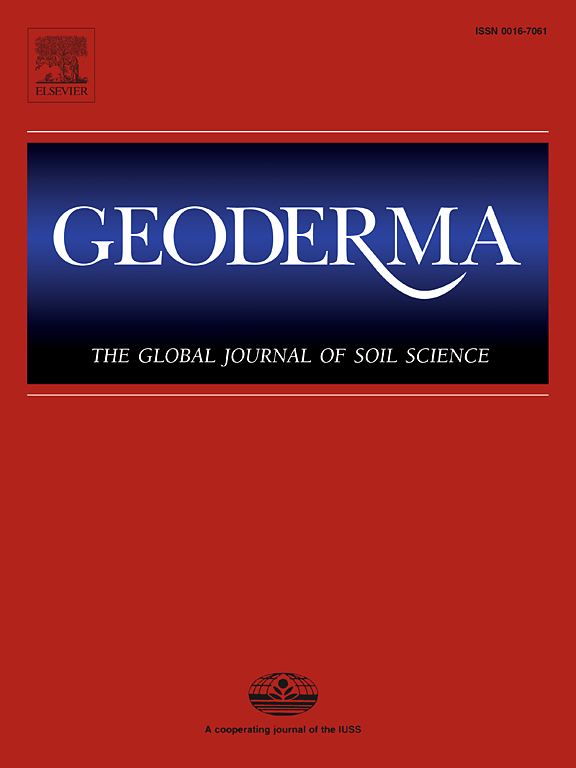Biogeographic patterns and adaptive strategies of microbial carbon metabolic profiles in paddy soils in the Chinese Mollisol region
IF 5.6
1区 农林科学
Q1 SOIL SCIENCE
引用次数: 0
Abstract
Microbial adaptive evolution and regulation strategies response to carbon (C) heterogeneity in paddy fields at large spatial scales remain poorly understood. Here, we employed gene- and genomic-centric metagenomic approaches to explore soil microbial biogeographic patterns and functional traits regulating C metabolisms across 120 soils derived from 30 paddy fields in Chinese Mollisols. Our findings revealed that significant distance-decay relationships (DDRs) were observed at both microbial C functional and genomic taxonomic levels. Microbial C cycling profiles were clustered into two groups. HCS (including sites R1-R10) represented soils with high total carbon (TC) at relatively high latitudes, whereas LCS (including sites R11-R30) had low soil C content distributed at low latitudes. Compared with HCS, LCS presented higher abundances of C cycling pathways involving aerobic respiration, C fixation, and methanogenesis pathways, as well as higher levels of carbohydrate esterase (CE) and glycosyl transferase (GT) classes. 211 metagenome-assembled genomes (MAGs) with diverse C metabolic functions were constructed. Among these, high-quality MAG292, assigned to the Nanopelagicales order, had a significantly positive correlation with TC and was more abundant in HCS. Contrarily, MAG153, assigned to the Chitinophagales order, exhibited an opposite trend. Additionally, 133 novel vMAGs were retrieved, and the abundances of phage11, phage16, phage26, and phage120 were higher in LCS than in HCS, containing chiA and GH19 that involved in chitin degradation. HCS had a relatively high abundance of phage89, containing slt and GH23 genes that regulate peptidoglycan lysis. These results indicated that soil viruses potentially lyse bacteria by encoding peptidoglycan lyase, releasing nutrients, and increasing the amount of dead microbial debris that facilitates soil C accumulation at relatively high latitudes. In contrast, at low latitudes, the phages together with microbes may indirectly decrease the soil TC by potentially expressing auxiliary metabolic genes (AMGs) involved in chitin degradation. Our findings indicate the divergent microbial adaptive evolution and soil C regulation strategies response to soil C heterogeneity in paddy soils of Chinese Mollisols.

中国Mollisol地区水稻土微生物碳代谢特征的生物地理格局及适应策略
在大空间尺度上,稻田微生物对碳(C)异质性的适应进化和调控策略尚不清楚。本研究采用以基因和基因组为中心的宏基因组学方法,研究了中国30个水田120种土壤的微生物生物地理模式和调节碳代谢的功能性状。研究结果表明,在微生物C功能和基因组分类水平上都存在显著的距离衰减关系(DDRs)。微生物C循环谱可分为两组。HCS(包括r1 ~ r10)在高纬度地区具有较高的总碳含量,而LCS(包括r11 ~ r30)在低纬度地区具有较低的土壤碳含量。与HCS相比,LCS具有更高丰度的碳循环途径,包括有氧呼吸、碳固定和甲烷生成途径,以及更高水平的碳水化合物酯酶(CE)和糖基转移酶(GT)。构建了211个具有不同C代谢功能的宏基因组组装基因组(MAGs)。其中,nanoelagicales目的优质MAG292与TC呈显著正相关,在HCS中含量更高。相反,隶属于几丁食菌目的MAG153则表现出相反的趋势。此外,133个新的vMAGs被检索到,LCS中噬菌体11、噬菌体16、噬菌体26和噬菌体120的丰度高于HCS,它们含有参与甲壳素降解的chiA和GH19。HCS具有相对高丰度的phage89,含有调节肽聚糖裂解的slt和GH23基因。这些结果表明,在相对高纬度地区,土壤病毒可能通过编码肽聚糖裂解酶、释放养分和增加死亡微生物碎片的数量来裂解细菌,从而促进土壤C的积累。相反,在低纬度地区,噬菌体与微生物可能通过潜在表达参与甲壳素降解的辅助代谢基因(AMGs)间接降低土壤TC。研究结果表明,中国软土水稻土微生物适应进化和土壤碳含量调控策略的差异响应了土壤碳含量的异质性。
本文章由计算机程序翻译,如有差异,请以英文原文为准。
求助全文
约1分钟内获得全文
求助全文
来源期刊

Geoderma
农林科学-土壤科学
CiteScore
11.80
自引率
6.60%
发文量
597
审稿时长
58 days
期刊介绍:
Geoderma - the global journal of soil science - welcomes authors, readers and soil research from all parts of the world, encourages worldwide soil studies, and embraces all aspects of soil science and its associated pedagogy. The journal particularly welcomes interdisciplinary work focusing on dynamic soil processes and functions across space and time.
 求助内容:
求助内容: 应助结果提醒方式:
应助结果提醒方式:


